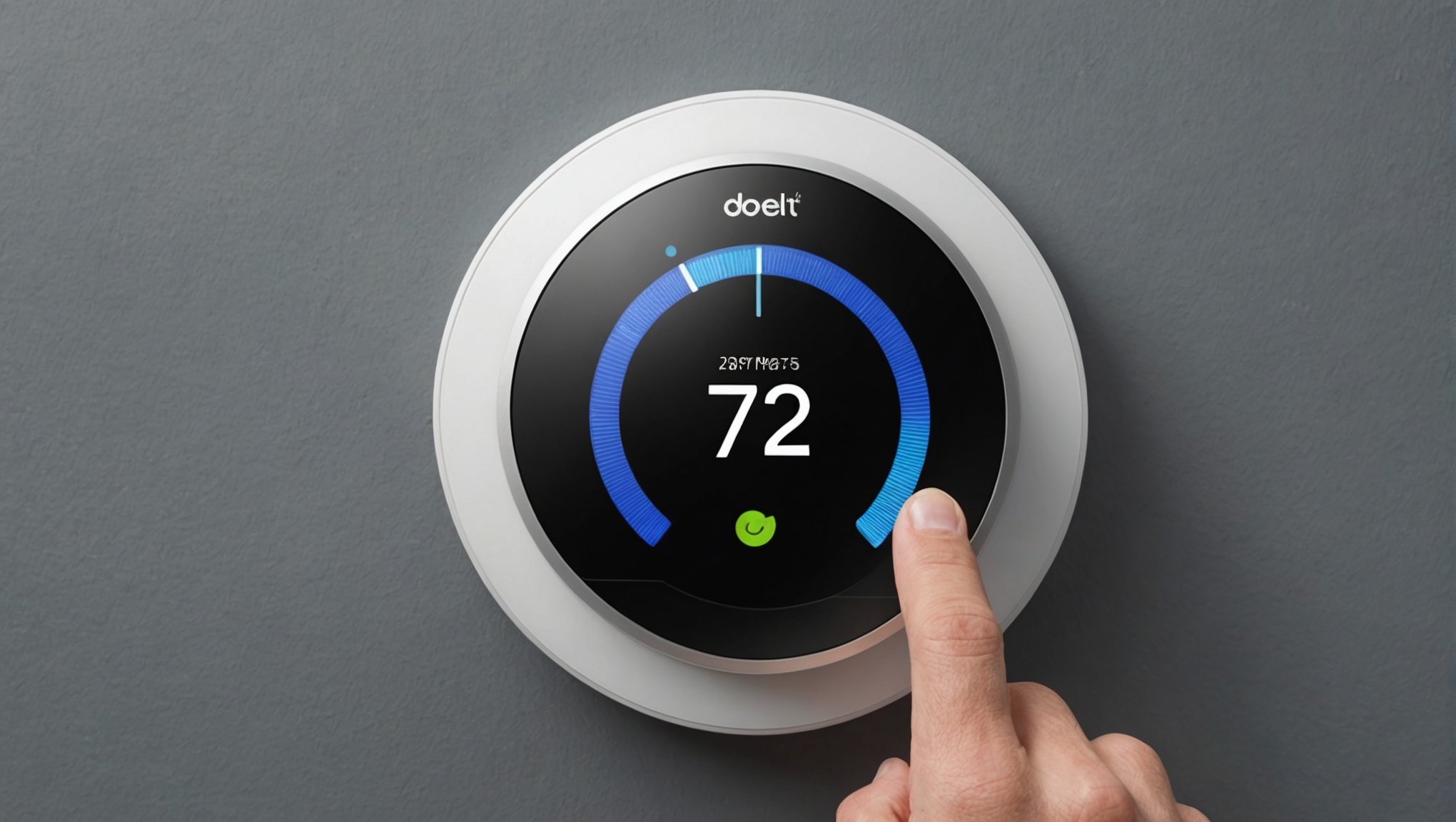Smart thermostats have transformed how we manage home temperatures, offering convenience and energy efficiency at our fingertips. Control and monitor your indoor climate effortlessly with just your smartphone. Discover how these advanced devices learn your preferences, adapt to your lifestyle, and ultimately save you money. Say goodbye to manual adjustments and hello to a smarter, more comfortable living environment. Unlock the full potential of your smart home and learn to master your thermostat for optimal temperature control.
Understanding Smart Thermostats
Smart thermostats are revolutionising home automation by offering advanced temperature control solutions. These devices allow homeowners to manage their home's climate efficiently and conveniently. By integrating with smartphones, smart thermostats provide remote access, enabling users to adjust settings from anywhere. This feature not only enhances comfort but also contributes to energy savings.
Topic to read : Maximize Your Smart Home”s Energy Savings: Smart Strategies Using Your Smartphone
Overview of Smart Thermostat Technology
At the core of smart thermostats is their ability to learn and adapt to your schedule. They use sensors and algorithms to understand your preferences and optimise heating and cooling patterns. This technology ensures that your home maintains the desired temperature without unnecessary energy consumption.
Benefits of Smartphone Integration
The integration of smart thermostats with smartphones offers significant advantages. Users can receive real-time notifications, monitor energy usage, and make adjustments on the go. This connectivity ensures that your home's temperature control is always at your fingertips, enhancing both convenience and efficiency.
Also to discover : Mastering Smart Blinds: A Guide to Smartphone Control for Ultimate Convenience
Key Features to Look For
When choosing a smart thermostat, consider features like compatibility with existing systems, ease of installation, and user-friendly interfaces. Additionally, look for models with advanced scheduling options and energy usage reports. These features ensure you get the most out of your smart thermostat, aligning with your home automation goals.
Setting Up Your Smart Thermostat
Installing a smart thermostat may seem daunting, but with a clear installation guide, it becomes a manageable task. Begin by turning off the power to your heating and cooling system to ensure safety. Remove the old thermostat, taking note of the wiring configuration. Most smart thermostats come with a detailed installation guide that matches wire labels to their respective terminals.
Connecting Your Smart Thermostat to Wi-Fi
Once installed, the next step is to connect your smart thermostat to Wi-Fi. This connection is crucial for remote access and smartphone app integration. Follow the on-screen instructions on your thermostat to select your home network and enter the password. Successful Wi-Fi connection allows your thermostat to communicate with your smartphone and other smart devices.
Downloading and Configuring the Smartphone App
To fully utilise your smart thermostat's capabilities, download the corresponding smartphone app. This app is essential for smartphone app integration, enabling you to control your thermostat remotely. After downloading, follow the app's setup instructions to pair it with your thermostat. Customise settings such as temperature preferences and schedule adjustments directly through the app, ensuring optimal comfort and energy efficiency.
Controlling Room Temperatures via Smartphone
Smart thermostats offer unparalleled mobile control, allowing users to manage home temperatures with ease. Through the smart thermostat app, you can adjust settings remotely, ensuring your home is always at the ideal temperature. Simply open the app, select the desired room, and make your temperature adjustment. This feature is especially useful when you're away from home but want to ensure comfort upon return.
Scheduling Temperature Changes Using the App
The app also enables you to schedule temperature changes in advance. You can set specific temperatures for different times of the day, aligning with your routine. This automation not only enhances comfort but also maximises energy efficiency by heating or cooling only when necessary.
Utilizing Geofencing Features for Optimized Comfort
Geofencing is another innovative feature available in many smart thermostat apps. By using your smartphone's location, geofencing automatically adjusts your home's temperature based on your proximity. For instance, it can lower the heat when you leave and raise it as you approach home. This ensures your living space is always comfortable while conserving energy, making your smart thermostat a truly intelligent investment.
Energy Efficiency and Savings
Smart thermostats play a pivotal role in enhancing energy efficiency within your home. By learning your schedule and adjusting heating and cooling patterns accordingly, these devices minimise unnecessary energy consumption. This not only contributes to a more sustainable environment but also translates into significant cost savings on your energy bills.
Maximising Energy Efficiency
To fully leverage your smart thermostat's capabilities, consider implementing these strategies:
- Regularly update your thermostat's schedule to align with your daily routine.
- Utilise the geofencing feature to automatically adjust temperatures based on your location.
- Take advantage of the advanced scheduling options to optimise temperature settings for different times of the day.
Analyzing Energy Usage Reports
Many smart thermostats provide detailed energy usage reports via their smartphone apps. These reports offer insights into your consumption patterns, helping you identify areas for improvement. By analysing this data, you can make informed decisions to further enhance your home's energy efficiency. Adjust settings based on these insights to maximise both comfort and savings, making your smart home truly intelligent and economical.
Comparing Popular Smart Thermostat Models
Choosing the right smart thermostat can be simplified by understanding the differences between top brands and models. A comprehensive smart thermostat comparison involves examining key features, pricing, and user feedback.
Overview of Top Smart Thermostat Brands and Models
Several brands dominate the market, including Nest, Ecobee, and Honeywell. Each offers unique features tailored to different user needs. For instance, Nest is renowned for its learning capabilities, while Ecobee integrates well with smart home systems. Honeywell models are favoured for their reliability and user-friendly interfaces.
Key Features and Pricing Comparison
When conducting a smart thermostat comparison, consider features like voice control, compatibility with smart home devices, and energy-saving modes. Prices vary: Nest models typically range from £180-£250, Ecobee from £200-£280, and Honeywell from £150-£230. Balancing cost with features ensures you find the best fit for your home.
User Reviews and Expert Recommendations
Product reviews highlight user satisfaction with ease of use and energy savings. Experts often recommend models based on specific needs, such as compatibility with existing systems or advanced scheduling options. By analysing market analysis and user feedback, you can make an informed decision on the best smart thermostat for your home.
Troubleshooting Common Issues
Experiencing smart thermostat problems can be frustrating, but a comprehensive troubleshooting guide can help resolve many issues. Understanding common issues and knowing when to seek professional help is vital for maintaining your device.
Identifying Common Issues
Smart thermostats may encounter problems like connectivity issues, incorrect temperature readings, or unresponsive touchscreens. Often, these issues stem from Wi-Fi disruptions, outdated firmware, or incorrect settings. Identifying the root cause is the first step in the troubleshooting process.
Step-by-Step Troubleshooting Procedures
For connectivity problems, ensure your thermostat is within range of your Wi-Fi router and verify network settings. If temperature readings are inaccurate, recalibrate the thermostat or check for blocked sensors. An unresponsive touchscreen may require a simple restart or a firmware update. Follow the manufacturer's troubleshooting guide for specific instructions tailored to your model.
When to Seek Professional Help
If troubleshooting steps fail to resolve the issue, it may be time to consult technical support or a professional technician. Persistent problems like electrical issues or complex software errors often require expert intervention. Seeking professional help ensures your smart thermostat operates efficiently and safely.
Real User Testimonials and Experiences
Exploring user testimonials provides valuable insights into the real-world performance of smart thermostats. Customer experiences often highlight the practical benefits and occasional challenges encountered. Many users praise these devices for their ability to optimize energy efficiency and enhance comfort. One user noted, "My smart thermostat has significantly reduced my energy bills while maintaining a comfortable home environment." Such feedback underscores the potential for cost savings and improved living conditions.
Users frequently mention the convenience of remote control and smartphone integration, allowing them to adjust settings from anywhere. A customer shared, "The ability to control my home's temperature while away is a game-changer." This feature is particularly appreciated by those with unpredictable schedules.
Expert insights on smart thermostat feedback reveal that reliability and ease of use are common themes among satisfied users. Experts recommend considering user reviews when selecting a model, as they often provide a realistic picture of the device's performance. By analyzing these experiences, potential buyers can make informed decisions, ensuring their chosen smart thermostat aligns with their needs and expectations.











